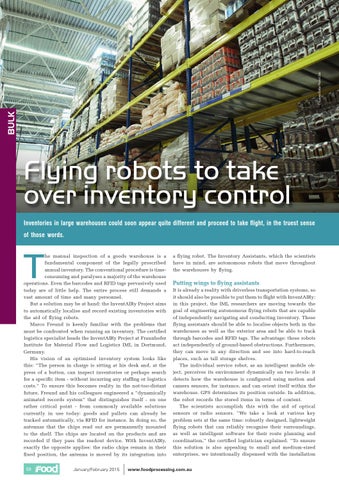© Kadmy/Dollar Photo Club
BULK
Flying robots to take over inventory control Inventories in large warehouses could soon appear quite different and proceed to take flight, in the truest sense of those words.
T
he manual inspection of a goods warehouse is a fundamental component of the legally proscribed annual inventory. The conventional procedure is timeconsuming and paralyses a majority of the warehouse operations. Even the barcodes and RFID tags pervasively used today are of little help. The entire process still demands a vast amount of time and many personnel. But a solution may be at hand: the InventAIRy Project aims to automatically localise and record existing inventories with the aid of flying robots. Marco Freund is keenly familiar with the problems that must be confronted when running an inventory. The certified logistics specialist heads the InventAIRy Project at Fraunhofer Institute for Material Flow and Logistics IML in Dortmund, Germany. His vision of an optimised inventory system looks like this: “The person in charge is sitting at his desk and, at the press of a button, can inspect inventories or perhaps search for a specific item - without incurring any staffing or logistics costs.” To ensure this becomes reality in the not-too-distant future, Freund and his colleagues engineered a “dynamically animated records system” that distinguishes itself - on one rather critical point - from commonly available solutions currently in use today: goods and pallets can already be tracked automatically, via RFID for instance. In doing so, the antennas that the chips read out are permanently mounted to the shelf. The chips are located on the products and are recorded if they pass the readout device. With InventAIRy, exactly the opposite applies: the radio chips remain in their fixed position, the antenna is moved by its integration into 58
January/February 2015
a flying robot. The Inventory Assistants, which the scientists have in mind, are autonomous robots that move throughout the warehouses by flying.
Putting wings to flying assistants It is already a reality with driverless transportation systems, so it should also be possible to put them to flight with InventAIRy: in this project, the IML researchers are moving towards the goal of engineering autonomous flying robots that are capable of independently navigating and conducting inventory. These flying assistants should be able to localise objects both in the warehouses as well as the exterior area and be able to track through barcodes and RFID tags. The advantage: these robots act independently of ground-based obstructions. Furthermore, they can move in any direction and see into hard-to-reach places, such as tall storage shelves. The individual service robot, as an intelligent mobile object, perceives its environment dynamically on two levels: it detects how the warehouse is configured using motion and camera sensors, for instance, and can orient itself within the warehouse. GPS determines its position outside. In addition, the robot records the stored items in terms of content. The scientists accomplish this with the aid of optical sensors or radio sensors. “We take a look at various key problem sets at the same time: robustly designed, lightweight flying robots that can reliably recognise their surroundings, as well as intelligent software for their route planning and coordination,” the certified logistician explained. “To ensure this solution is also appealing to small and medium-sized enterprises, we intentionally dispensed with the installation
www.foodprocessing.com.au
